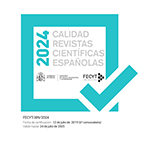The baroque. History of an aesthetic concept from interwar Europe to postmodernity
Abstract
Beyond the use of the term baroque in reference to a specific period of cultural history in Europe and Latin America, which would include the seventeenth and early eighteenth centuries, the concept has served to characterize periods of profound crisis of values. This was the case in 1935 when Eugenio d'Ors, in the context of interwar Europe, denounced what he understood to be the predominance of a baroque spirit that undermined the great classicist tradition. This happened again in the midst of the postmodern crisis when various authors such as Omar Calabrese, Charles Jenks, and Gilles Deleuze recovered the concept as a tool to define the crisis of modernism. Between one moment and another, the categories of the baroque and the neo-baroque were useful to characterize Latin American culture in authors such as Lezama Lima, Severo Sarduy, or Alejo Carpentier. Our purpose is to show the mutations of the concept in order to understand how different periods seemed to obey the same logic and how the same aesthetic category could serve to characterize such different moments
Downloads
Article download
License
In order to support the global exchange of knowledge, the journal Res Publica. Revista de Historia de las Ideas Políticas is allowing unrestricted access to its content as from its publication in this electronic edition, and as such it is an open-access journal. The originals published in this journal are the property of the Complutense University of Madrid and any reproduction thereof in full or in part must cite the source. All content is distributed under a Creative Commons Attribution 4.0 use and distribution licence (CC BY 4.0). This circumstance must be expressly stated in these terms where necessary. You can view the summary and the complete legal text of the licence.









